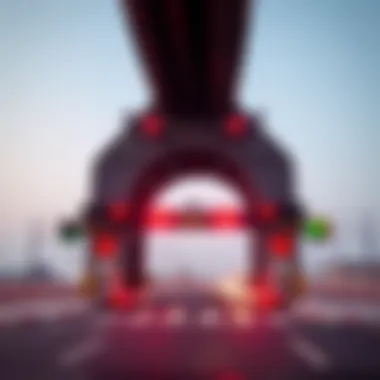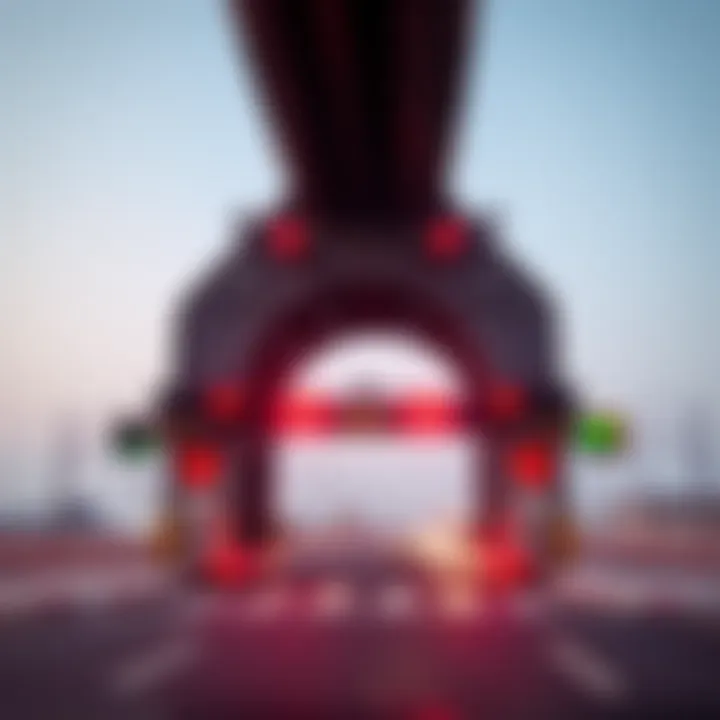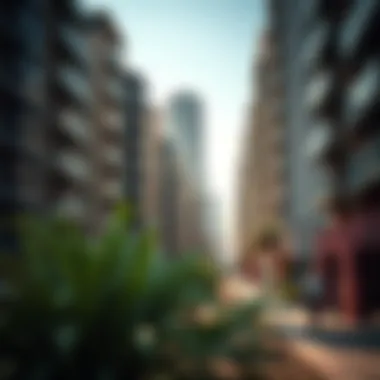Darb Salik: Impact on Dubai's Urban Development


Intro
Darb Salik has become a defining feature of Dubai’s urban environment, aiming to address the complexities of rapidly growing urbanization. It serves as much more than a mere toll collection system; it represents a shift in how cities can adapt and manage resources. Through a closer look at its operational strategy and its ripple effects on various sectors, we can better appreciate the nuances involved in this modern urban policy.
Understanding the workings of Darb Salik offers vital insights for investors, urban planners, and residents alike. As the city continues to evolve, a comprehensive grasp of its toll system is crucial in navigating the landscape of opportunities and challenges that come with urban growth. Not getting a read on these dynamics could leave investors and stakeholders a step behind in the ever-competitive real estate and transportation arenas.
Darb Salik’s influence is intertwined with a variety of factors—traffic flow, environmental considerations, and urban planning, all playing critical roles in Dubai’s development strategy. To untangle these threads is to appreciate the interplay between modern transportation systems and urban life in this vibrant city.
By delving deeper into the potential financial impacts and environmental outcomes of the toll system, this analysis equips our readers with critical knowledge. The forthcoming sections will weave together a well-rounded picture of how Darb Salik is reshaping Dubai, offering a blend of current trends, investment opportunities, and future forecasts.
The question remains: How does a simple efficiency tool like a toll system morph into a cornerstone of urban transformation? Let’s explore this fundamental aspect of Dubai’s infrastructure together.
Prelims to Darb Salik
The introduction of a toll system can often stir debate, but Darb Salik embodies a significant shift in Dubai's urban infrastructure strategy. This piece aims to illuminate how this system influences traffic behavior, urban development, and ultimately the economic fabric of the city. Understanding the nuances of Darb Salik is crucial, especially for investors, agents, homebuyers, and managers keeping a keen eye on Dubai’s flourishing landscape.
Definition and Purpose
Darb Salik, translated as "The Clear Path," is Dubai's electronic toll collection system initiated to manage vehicular traffic through its busiest roads with efficiency. Its primary purpose is to reduce congestion and optimize road usage. The system is designed not just for revenue generation but also to promote efficient transportation by encouraging users to reconsider their travel routes and times. As the old adage goes, "time is money;" in this case, it encourages commuters to explore alternative routes, easing the strain on heavily trafficked roads.
Key benefits include:
- Decrease in traffic congestion during peak hours
- Financial reinvestment into infrastructure improvements
- Encouragement of public transport usage, bolstered by an enhanced road network
As the lifeblood of a city, roads dictate not only how residents and visitors traverse the area but also influence real estate demand and urban planning initiatives. In a city like Dubai, where urban sprawl and swift development are king, the successful implementation of a tolling system is a cornerstone of effective city planning.
Historical Context
To appreciate the context of Darb Salik, it's essential to take a step back and glance at Dubai's rapid evolution as a global hub. Prior to the integrated toll system, heavy traffic congestion plagued major routes, which deterred the smooth flow of both daily commuters and tourists. The introduction of Darb Salik in 2007 marked a new chapter, addressing this pressing issue.
Dubai's journey to becoming a modern metropolis was paved with aspirational goals, including fostering sustainable urban growth and attracting international business. The toll initiative reflected a collection of these goals—introducing not only a traffic management solution but also funding necessar nearby projects, including
- Road expansions
- Public transport enhancements
- Infrastructure resilience initiatives
In the years following its inception, the toll system has seen adjustments focused on further optimizations, showcasing a city that evolves based on its residents' and visitors' needs.
Understanding Darb Salik requires more than knowledge of its functions; it’s about recognizing how this endeavor sits at the intersection of economic growth and urban planning. This framework informs not only how roads are navigated but also how stakeholders engage with the city’s growth narratives.
Framework of the Toll System
The Framework of the Toll System is pivotal in dissecting how Darb Salik operates within the larger context of Dubai's urban setting. It underpins the mechanisms that facilitate smooth traffic flow, funding for infrastructure projects, and addressing sustainability concerns. Understanding this framework can help stakeholders – from investors to urban planners – gauge its efficacy and potential long-term impacts on the city's development.
Operational Mechanism
At its core, the operational mechanism of the Darb Salik toll system involves automated tollgates strategically placed across major roads in Dubai. These gates function on a cashless electronic system, allowing vehicles to pass without stopping, which is a crucial factor in maintaining flow and minimizing delays. Below are some key points explaining how this mechanism functions:
- Tag Technology: Vehicles are equipped with a Salik tag, which automatically deducts toll fees as they pass through the gates. This technology works seamlessly, ensuring drivers do not sit in traffic waiting to pay.
- Real-Time Monitoring: The system is equipped to monitor traffic patterns in real-time, providing crucial information for traffic management and planning. This data can help adjust toll rates dynamically based on congestion levels.
- Adjustment Flexibility: Its operational framework allows for modifications based on user trends, traffic flow, and urban growth. This adaptability is essential for future-proofing the toll system in an ever-expanding metropolis.
The mechanisms in place facilitate accountability and transparency, allowing city planners to evaluate congestion points and adjust urban infrastructure accordingly.
Fee Structure
Understanding the fee structure of the toll system is crucial for stakeholders, as it directly impacts transportation costs for residents and businesses alike. First off, the fee system is structured in a way to encourage optimal utilization of road networks without stifling mobility.
- Basic Toll Rates: Typically, drivers pay a standard fee for passing through each toll gate. This rate is set to cover the operational costs while promoting the responsible use of major routes. The base fee is around 4 AED for each passage, making it crucial for planning daily commuting expenses.
- Time-Based Adjustments: During peak hours, the fees can spike, which helps in regulating traffic and encouraging drivers to opt for alternative routes or travel during off-peak hours. This time-sensitive pricing not just alleviates congestion but also maximizes efficient route usage.
- Incentives for Frequent Users: For regular commuters, savings schemes or cap limits on toll fees might be available, making the system more palatable for everyday use. This encourages residents to use the toll routes while still generating revenue for the city’s infrastructure initiatives.
In summary, the fee structure plays a fundamental role in ensuring that the toll system remains economically viable while simultaneously encouraging responsible driving behavior and effective use of Dubai's roadway networks.
"Toll systems like Darb Salik are not just about revenue; they're about shaping a smarter city through strategic urban planning."
The framework surrounding the toll system thus serves as an essential component of Dubai's urban development strategy, benefitting both the municipality and its residents.
Impact on Traffic Patterns
The impact of Darb Salik on traffic patterns in Dubai offers a lens into the complex web of urban mobility that defines the city’s infrastructure. As one of the key components of Dubai’s road-user framework, Darb Salik plays a pivotal role not merely in managing vehicles but also in shaping the entire transportation ethos of the region. Understanding this impact requires a multifaceted approach, diving into elements like traffic flow, congestion levels, and how drivers navigate this bustling urban environment.


Traffic Flow Analysis
Traffic flow is essentially the lifeblood of any city's movement system, influencing everything from commute times to road safety. In Dubai, the implementation of the Darb Salik toll system has notably contributed to more streamlined traffic patterns. Initially, the anticipation was that tolls would deter vehicular congestion in some of the busiest areas, such as Sheikh Zayed Road and Al Maktoum Bridge.
Evidence suggests that since the introduction of the tolls, monitored traffic data has depicted a more organized flow during peak hours. The toll system encourages drivers to plan their journeys more strategically, often opting for less congested routes as they weigh the costs associated with crossing toll gates. This has underscored a shift towards a more efficient use of road infrastructure, as drivers become cognizant of peak hours and adjust their travel accordingly.
A study conducted by the Roads and Transport Authority indicates that average travel times have diminished for daily commuters due to the incentives embedded within the toll structure. Rather than being constrained by heavy delays, drivers are finding that adapting their driving habits not only saves time but also improves overall road safety.
Congestion Mitigation Strategies
When it comes to mitigating congestion, the strategic placement of toll gates throughout Dubai serves as one of the most proactive approaches the emirate has taken. The Darb Salik system acts as a mechanism to alleviate bottlenecks by discouraging unnecessary trips through the most congested areas. As vehicles opt out of toll-laden routes, alternative pathways become less burdened, enabling smoother transit even during rush hours.
Several methods supplement this tolling strategy, ensuring that the city's traffic remains manageable:
- Dynamic Toll Pricing: Adjustments in toll costs based on real-time traffic conditions have shown promise in regulating flow. If traffic spikes, the system can increase the toll briefly to discourage non-essential travel, effectively redistributing vehicles to less crowded roads.
- Integrated with Public Transport: The tolling framework has been designed in tandem with public transit solutions, incentivizing drivers to switch to buses or metro systems, reducing the number of cars on the road.
- Data-Driven Infrastructure Enhancements: Continuous monitoring of traffic patterns informs improvements to road networks, such as adding lanes or reconfiguring junctions to handle increased volumes where necessary.
In summary, understanding the dynamics around Darb Salik provides insights into a broader strategy that Dubai employs to enhance its urban landscape. The impacts on traffic patterns underscore a commitment to better mobility, aiming to thrust the city towards a more sustainable and efficient urban environment.
"By rethinking tolling and traffic flow, we are not simply managing vehicles; we are shaping how people perceive mobility in their urban experience." - Transportation Expert
Through this analytical lens, traffic patterns are not just affected by a toll but rather transformed by integrated strategies that resonate with the aspirations of a growing metropolis. More discussions around this topic can be found on broader platforms like Wikipedia or even community insights on Reddit.
Urban Development Consequences
When discussing urban development in Dubai, the Darb Salik toll system is central to understanding how urban planning and infrastructure investments pivot from basic transport needs to more sophisticated land use strategies. This section explores the multifaceted consequences of Darb Salik on the urban landscape, particularly its influence on real estate prices and zoning regulations. The implications are significant, not just for urban planners but also for investors, businesses, and potential residents looking to navigate Dubai's dynamic real estate market.
Influence on Real Estate Prices
Darb Salik has noticeably affected real estate prices across the city. The introduction of tolls has a dual effect: on one hand, it can deter potential buyers from areas that require multiple toll crossings, while on the other, it encourages development in areas that become more accessible and desirable once the tolls are in place.
For instance, areas adjacent to key toll gates have seen upward pressure on property values due to improved accessibility. Investors are increasingly willing to pay a premium for properties that are well-connected to essential roads and hubs of activity. As a result, homes or commercial spaces located near these points tend to appreciate faster than those in more isolated locations.
Moreover, developers now eye these proximity advantages when planning new projects. As potential buyers closely monitor the toll system's impact, they are likely to gravitate towards locations that either minimize toll-related costs or boast alternative indirect access routes. This creates a shift in demand that directly influences pricing strategies.
- Factors influencing real estate pricing in relation to tolls:
- Proximity to toll gates
- Accessibility of alternative routes
- Development plans surrounding the toll areas
"The real estate market in Dubai is like a tide; it shifts with infrastructure changes. Those who adapt quickly stand to gain the most."
Zoning and Land Use Considerations
The toll system is not just about generating revenue; it significantly shapes zoning and land use policies intended to optimize urban space. The introduction of Darb Salik has prompted city planners to rethink how land can be utilized more efficiently. Certain areas might be earmarked for commercial developments due to increased traffic flow resulting from the toll system.
For example, the zoning regulations can incentivize mixed-use developments where residential, commercial, and recreational spaces coexist harmoniously, creating a balanced urban ecosystem. This strategy aims not only at enhancing the value of land but also at providing convenience and opportunities for local businesses.
The demands placed on traffic management by the toll system often challenge existing zoning classifications. Planners find themselves in discussions about:
- Adjusting land uses in high-traffic areas: Encouraging offices and retail spaces that cater to commuters.
- Promoting transit-oriented developments: Enhancing residential areas near public transport links that minimize dependency on toll roads.
This proactive approach ensures that the urban landscape remains adaptable and resilient, keeping pace with how residents interact with the city's infrastructure.
Environmental Considerations
Evaluating the environmental considerations surrounding the Darb Salik toll system is vital, particularly in today’s context of heightened awareness around urban sustainability. The implications extend beyond mere traffic management and dive deep into how the system interacts with air quality, noise pollution, and the overall ecological footprint of the city.
Air Quality and Emissions Research
An important component of understanding the environmental impact of Darb Salik is focusing on air quality. Greater traffic flow typical in urban settings can lead to increased emissions of harmful pollutants. Studies highlight that toll systems, such as Darb Salik, have the potential to enhance air quality in the long run by managing congestion better. When vehicles spread out and reduce idling time, emissions corresponding to vehicles' movement decrease markedly.
In a broader sense, studies from various cities have shown that regions with effective toll strategies can see a drop in nitrogen oxides and particulates. In Dubai, factors contributing to air quality, such as rapid urbanization and population growth, necessitate a system that does not just ease travel but does so while keeping an eye on environmental standards.
"Cities that embrace sustainable transportation systems may find they enjoy the dual benefits of traffic reduction and improved air quality."
Research efforts in this area emphasize data collection through air quality monitoring stations around Toll gates. Continuous analysis allows for immediate responses to spikes in pollution caused by heavy traffic times, potentially ushering in tailored regulations and interventions.


Sustainable Transportation Solutions
Sustainable transportation solutions become paramount when considering the outcomes of a toll system like Darb Salik. The integration of tools such as electronic payment systems not only simplifies the tolling process but encourages shifts towards carpooling and the use of public transport. This is crucial in a city that is relatively young in its formation yet grows at a pace that can outstrip public transport infrastructure.
As part of sustainability goals, there has been a growing interest in promoting electric vehicles (EVs), which garner lower toll rates under the Darb Salik policy. These incentives can actively steer residents and outsiders toward greener commuting options.
Key advantages include:
- Reduction in Individual Emissions: EV drivers experience lower costs with minimal negative environmental footprints.
- Increased Public Transport Utility: Investments into public transport associated with toll income can make commuting more appealing.
- Infrastructure Development: The toll proceeds can support projects that strengthen pedestrian and cycling pathways, benefiting the community and the environment.
Over the long haul, these strategies may potentially lead to a ripple effect where an improved perception of sustainable transport options manifests through better air quality and decreased reliance on fossil fuels. Emphasizing eco-friendly solutions as part of the urban development narrative in Dubai not only shows awareness but fosters an environment rich in ecological responsibility.
Stakeholder Perspectives
Understanding how Darb Salik affects different groups within Dubai provides a nuanced view of the broader consequences of the toll system. Individual stakeholders—be they residents, business owners, or city planners—play a pivotal role in shaping the urban landscape. By analyzing their perspectives, we can gain deeper insights into the outcomes of this policy on everyday life.
Residents' Reactions
For residents, Darb Salik has been a double-edged sword. On one hand, some folks argue that the reduced traffic congestion due to toll implementation is a breath of fresh air, making commutes shorter and more predictable. A local resident with a daily trip to work might find the added fees worthwhile if it slashes travel time. However, there’s also considerable frustration surrounding the costs associated with the toll system.
- Key Concerns:
- Economic Burden: For lower-income residents, the tolls can represent a significant financial burden. The monthly fees may eat into budgets that are already stretched thin, creating concern about equity among different classes of the populace.
- Accessibility Issues: There are apprehensions regarding how tolls can affect access to essential services. When tolls are applied to routes that lead to schools, hospitals, or grocery stores, it can deter residents from frequenting those areas.
Engaging residents in community forums could help address these issues. Feedback might indicate necessary adjustments or even the implementation of discounts for essential trips. From surveys circulating on platforms like Reddit or community pages, it’s clear that many residents feel a mix of acceptance and resentment, leading to interesting discussions about fairness and functionality in transportation policy.
Business Impact Analysis
Businesses in the Dubai area view Darb Salik through a distinct lens. The toll system can fluctuate between being a boon or a bane, depending largely on the type of enterprise in question.
- Positive Outcomes:
- Challenges:
- Reduced Traffic Congestion: For some businesses, smoother traffic flow leads to quicker deliveries and increased foot traffic to storefronts. For example, a restaurant in Downtown Dubai may benefit from quicker access to suppliers, thus ensuring fresh produce and timely service.
- Enhanced Urban Development Appeal: As city planners aim for a streamlined transport system, businesses in transport-adjacent areas may experience growth, thanks to improved accessibility.
- Financial Constraints: However, for companies relying on customer visits—like retail shops—any increase in consumer costs can sour the deal. If a customer has to think twice about paying a toll just to grab some groceries, that might translate into lower sales. Small businesses often voice dissatisfaction regarding the lack of foot traffic caused by the tolls, marking a stark contrast to what larger corporations face.
- Operational Costs: Additionally, companies that rely on vehicle fleets may need to factor in toll costs into their operational budgets. This could lead to price increases for consumers, thereby affecting competitiveness.
Overall, the feedback from businesses is decidedly mixed, highlighting a pressing concern regarding the balance between maintaining operational feasibility and managing customer experiences.
"In the end, whether it’s ease of access or financial burden, the effects of Darb Salik ripple through the community, creating a landscape that requires ongoing dialogue and adjustments to serve all stakeholders better."
In summary, the implications of Darb Salik for residents and businesses in Dubai are complex and ever-evolving. Understanding these perspectives is crucial when considering future urban planning and transportation policies. Engaging directly with stakeholders can help create a more balanced approach, benefiting all parties involved.
Technological Integration
The advent of technology continually reshapes the infrastructure landscape, making it imperative to understand how Darb Salik leverages modern advancements. The integration of technology within this toll system not only streamlines operations but also enhances user experience, making it an indispensable part of Dubai's urban development.
Smart Tolling Systems
At the core of Darb Salik’s efficiency are its smart tolling systems. These systems utilize advanced technology, including Automatic Number Plate Recognition (ANPR) and RFID (Radio Frequency Identification) to manage toll payments. When a vehicle passes through a toll gate, the system captures the license plate, and the toll is automatically deducted from the user's account. This contactless experience cuts down on delays often seen with traditional toll booths, improving the overall traffic flow.
The benefits of smart tolling extend beyond mere convenience. For Dubai, which prides itself on innovation, such systems reflect a commitment to enhancing urban mobility. These systems help to collect real-time data on traffic volumes, which can inform city planners in their decision-making processes.
Moreover, these smart solutions enable customizable user experiences; for instance, frequent users can enroll in reduced-fee programs or receive notifications about traffic conditions. In a city as dynamic as Dubai, this kind of responsiveness is a game changer. It empowers not only the drivers but also the city itself to adapt to traffic patterns as they evolve.
Data Analysis Applications
The data generated by the smart tolling systems presents a treasure trove of information. This is where data analysis applications come into play. By utilizing data analytics, officials can glean insights into vehicle behaviors, peak traffic times, and overall highway efficacy. This helps outline future urban plans and potentially forecast infrastructure needs.
"Data is a critical asset in urban planning, allowing cities to make informed decisions based on real-world traffic patterns."
Compiling this data enhances the efficiency of public transport systems, enabling a seamless connection between various modes of travel. City planners can analyze whether the current road networks meet the demands or if new routes are needed.
Furthermore, businesses can leverage insights from this data. For example, commercial entities can use it to anticipate customer arrival times, streamline deliveries, and optimize logistical operations. Thus, the data analysis applications within the Darb Salik framework not only foster improved urban infrastructure but also stimulate economic activities within Dubai.
Darb Salik's Future Developments


Darb Salik represents more than just a toll system in Dubai; it signifies a shift in urban mobility and planning. As the Emirate continues to evolve, understanding what comes next for Darb Salik is crucial not only for urban planners and government officials but for investors, businesses, and residents alike. The upcoming developments in this toll system will undoubtedly play an integral role in shaping the future of urban life in Dubai, affecting everyday commutes, the property market, and environmental sustainability.
Anticipated Changes in Policy
Changes in policy regarding the Darb Salik system are anticipated as the city navigates the challenges of exponential growth. The government may look at policies that accommodate increased vehicle numbers without compromising traffic flow efficiency. This could include adjustments in toll fees or even new incentives for carpooling or using public transport.
Furthermore, there's potential for the integration of smart technologies that can enhance user experiences. The implementation of dynamic pricing could be on the horizon, where toll costs vary based on traffic conditions, encouraging drivers to seek alternatives during peak hours. Such policies could not only reduce traffic but also drive a collective shift towards sustainable transportation.
Here are some key areas where policy changes may be observed:
- Dynamic Pricing: Introduction of variable toll rates to manage congestion.
- Public Transport Incentives: Initiatives to promote public transportation use among residents.
- Sustainability Emphasis: Policies that prioritize environmentally-friendly transport solutions, like electric vehicle lanes.
Long-term Urban Planning Goals
Looking ahead, the long-term urban planning goals associated with Darb Salik will focus on enhancing the overall livability of Dubai’s urban environment. This involves not just managing traffic but rethinking urban landscapes to create a more pedestrian-friendly city. Integrating public spaces, parks, and mixed-use developments around toll plazas could significantly reshape neighborhoods.
As part of the long-term strategy, investments in infrastructure such as bicycle lanes and pedestrian walkways will be crucial. This could ensure that the infrastructure is not solely car-centric but promotes alternative modes of transportation.
In summary, the future developments of Darb Salik are likely to:
- Support Sustainable Urban Mobility: Encouragement of multiple transport modes.
- Enhance Connectivity: Reduced travel times across the urban landscape.
- Promote Community Building: Mixed-use areas that foster social interaction.
"The future of urban transport hinges on our ability to evolve and adapt to changing dynamics, placing emphasis on sustainability and community well-being."
Understanding these anticipated changes and goals will empower stakeholders across the board to make informed decisions that align with Dubai's vision for a modern, efficient, and eco-friendly urban environment.
Comparative Analysis
The examination of Darb Salik's impact on urban development benefits significantly from a comparative analysis. This approach allows us to not only understand how this particular toll system operates within the unique context of Dubai but also to draw parallels with established toll systems worldwide. By stepping into the shoes of other cities, investors, urban planners, and residents alike can better grasp the nuances of tolling mechanisms and their broader implications.
International Toll Systems
Toll systems exist across the globe, each adapting to its local environment and urban structure. For instance, cities like New York with its Port Authority tolls and London with its congestion charge exhibit not just a means of revenue but also critical tools for traffic management and urban planning. These structures provide a wealth of insights into how toll systems can shape urban landscapes.
- New York City
- London
- Singapore
- Revenue Generation: Port Authority bridges and tunnels charge as much as $15 for a single crossing. This excess is funneled into infrastructure improvements.
- Traffic Management: The varying rates bring down rush hour congestion by discouraging unnecessary trips.
- Congestion Charge: Aimed at reducing traffic in central London, this charge promotes the use of public transport, yielding a 30% drop in vehicle entries into the zone.
- Environmental Impact: The system has also pushed for greener vehicles, enhancing air quality.
- Electronic Road Pricing (ERP): Utilizing real-time changes in charges based on traffic flow, ERP has significantly streamlined traffic management in a densely populated city.
Drawing from these examples, it's evident how localized tolling can address specific traffic and urban issues efficiently. The Darb Salik system, therefore, is not an isolated phenomenon; it is part of a larger trend of utilizing technology and economic incentives to shift urban dynamics.
Lessons from Other Cities
Studying other urban environments reveals valuable lessons that can be applied to enhance the effectiveness of Darb Salik. Here are some insights:
- Adaptability: Cities that succeed in altering their toll systems over time show higher levels of public compliance and satisfaction. Adjusting rates based on demand, like in Singapore, ensures fair access and efficient usage.
- Integration with Public Transport: The London model shows that a robust public transportation system reduces reliance on personal vehicles, potentially increasing the success of toll systems.
- Public Communication: Successful toll systems prioritize transparency and foster community engagement. When cities explain the reasoning behind tolling, such as funding infrastructure, residents are more likely to support it.
"Understanding global toll systems provides a wider lens through which to view Darb Salik's role in Dubai, showcasing both the potential for success and pitfalls to avoid."
By closely examining the comparative aspects and lessons learned from other cities, Dubai can not only refine its tolling approach but also ensure it meets its ambitious urban development goals. The ability to learn from diverse contexts can pave the way for innovative solutions tailored uniquely to Dubai's landscape.
Epilogue
The impact of Darb Salik on Dubai's urban development is a crucial element that deserves careful contemplation in the broader narrative of the city's growth and transformation. As a complex toll system, it extends far beyond mere revenue generation; it reshapes traffic patterns, influences real estate markets, and integrates technological advancements into the fabric of daily life.
Summary of Findings
Throughout this article, we have delved into various aspects of the Darb Salik toll system. Here are key points that encapsulate its significance:
- Traffic Management: The toll mechanism helps alleviate congestion by influencing driver behavior, encouraging alternative routes, and enhancing journey times. This has led to improved efficiency in urban mobility.
- Urban Planning: By adjusting land use and real estate prices, Darb Salik has molded how neighborhoods evolve. The desirability of locations around toll gates can spark development projects, reshaping the urban landscape.
- Environmental Impact: The overarching aim is to reduce emissions and promote more sustainable transport options. This aligns with global aims of cutting down on carbon footprints, making the city greener in the long run.
- Stakeholder Insights: Understanding how residents and businesses perceive the system sheds light on its broader ramifications. Many appreciate the reduction in travel times but voice concerns about accessibility and the toll on low-income communities.
Final Thoughts on Darb Salik
Looking ahead, the future of Darb Salik and its role within Dubai's urban context is poised for further evolution. As Dubai continues to embody a progressive and dynamic environment, the interplay between city infrastructure and toll systems will be pivotal. Lessons from international models can offer insights into enhancing effectiveness while considering social equity and environmental sustainability. The balance struck will be essential as urban planners and policymakers navigate the intricacies of a rapidly changing urban ecosystem.
Darb Salik serves not only as a revenue tool, but as a keystone in dialog among urban planners, businesses, and residents alike. Its implications stretch well beyond roadways, inviting a reevaluation of how infrastructure influences life in this bustling metropolis.
For readers seeking further information, consider exploring these resources:







